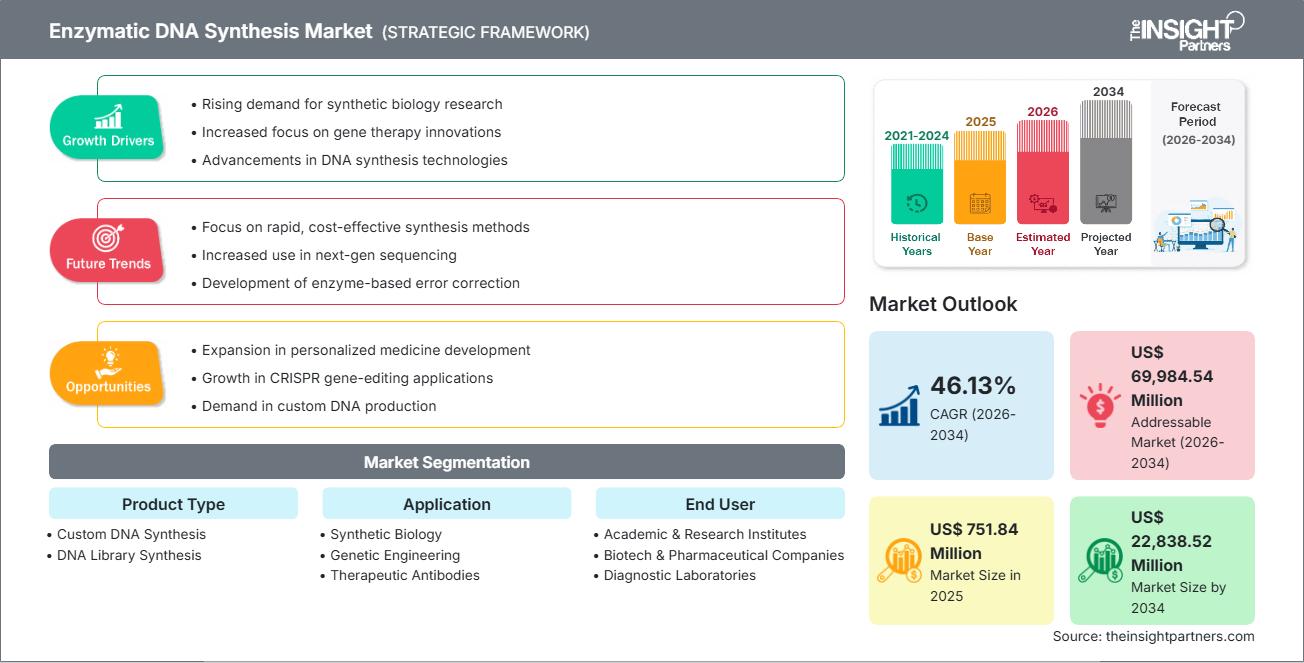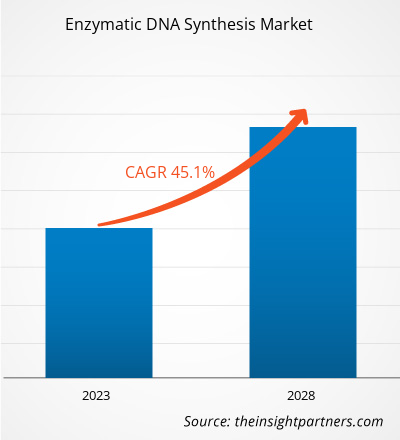Der Markt für enzymatische DNA-Synthese wird bis 2034 voraussichtlich ein Volumen von 22.838,52 Millionen US-Dollar erreichen, gegenüber 751,84 Millionen US-Dollar im Jahr 2025. Es wird erwartet, dass der Markt im Zeitraum 2026–2034 eine durchschnittliche jährliche Wachstumsrate (CAGR) von 46,13 % verzeichnen wird.
Marktanalyse zur enzymatischen DNA-Synthese
Der Markt für enzymatische DNA-Synthese (EDS) wächst rasant, vor allem aufgrund des Wandels von der konventionellen chemischen DNA-Synthese hin zu präziseren, skalierbaren und umweltfreundlicheren enzymbasierten Methoden. Diese fortschrittliche Technik nutzt Enzyme wie die terminale Desoxynukleotidyltransferase (TdT) oder Polymerase-basierte Plattformen zur Konstruktion von DNA-Strängen. Die zunehmende Anwendung synthetischer Biologie und gentechnischer Verfahren, insbesondere der CRISPR-Technologie, treibt die Nachfrage nach hochwertigen, maßgeschneiderten und längeren DNA-Fragmenten an. Unternehmen entwickeln verstärkt innovative Lösungen, um den Bedarf an schnellerer, saubererer und präziserer DNA-Produktion zu decken, die für die Wirkstoffforschung, die Impfstoffentwicklung und die personalisierte Medizin unerlässlich ist. Der EDS-Markt wird voraussichtlich durch steigende Investitionen in die Genomforschung, die Integration künstlicher Intelligenz (KI) zur Optimierung der Synthese und die wachsende Nachfrage nach ausgelagerten DNA-Synthesedienstleistungen weiter anwachsen.
Marktübersicht zur enzymatischen DNA-Synthese
Die enzymatische DNA-Synthese stellt einen bedeutenden technologischen Fortschritt in der Genomik und der synthetischen Biologie dar. Sie bietet gegenüber der traditionellen chemischen Synthese mehrere entscheidende Vorteile, darunter den Verzicht auf aggressive und toxische Chemikalien, was zu einem saubereren und nachhaltigeren Prozess führt. Zudem ermöglicht sie die Herstellung längerer und präziserer DNA-Stränge mit potenziell geringeren Fehlerraten. Die enzymatische DNA-Synthese beschleunigt die Bearbeitungszeiten und ist unerlässlich für moderne Anwendungen wie die molekulare Diagnostik, PCR-Assays und die Entwicklung von Nukleinsäure-basierten Therapien.
Passen Sie diesen Bericht Ihren Anforderungen an.
Sie erhalten eine kostenlose Anpassung aller Berichte – einschließlich Teilen dieses Berichts, Länderanalysen und Excel-Datenpaketen – sowie attraktive Angebote und Rabatte für Start-ups und Universitäten.
Markt für enzymatische DNA-Synthese: Strategische Einblicke

-
Ermitteln Sie die wichtigsten Markttrends dieses Berichts.Diese KOSTENLOSE Probe beinhaltet eine Datenanalyse, die von Markttrends bis hin zu Schätzungen und Prognosen reicht.
Markttreiber und Chancen für die enzymatische DNA-Synthese
Markttreiber:
- Zunehmende Forschungsförderung in der Genomforschung und Arzneimittelentwicklung: Die weltweit steigenden Ausgaben von Regierungen, Institutionen und Pharmaunternehmen für Genomprojekte, CRISPR-bezogene Technologien, Arzneimittelforschung und molekulare Diagnostik treiben die Nachfrage nach fortschrittlichen DNA-Synthesemethoden an.
- Zunehmender Wandel von der chemischen zur enzymbasierten DNA-Synthese: Der Markt erlebt einen deutlichen Übergang zu enzymatischen Methoden, bedingt durch die Nachfrage nach höherer Präzision, geringeren Fehlerraten und umweltfreundlicher Produktion. Enzymatische Verfahren minimieren Produktionsabfälle und verbessern die Skalierbarkeit.
- Zunehmender Einsatz von CRISPR und Werkzeugen der synthetischen Biologie: Die zunehmende Implementierung der CRISPR-Technologie und der synthetischen Biologie in der personalisierten Medizin, der Agrarbiotechnologie und der Gentechnik steigert die Nachfrage nach maßgeschneiderten und qualitativ hochwertigen DNA-Syntheselösungen.
Marktchancen:
- Integration von Künstlicher Intelligenz (KI): Es wird erwartet, dass die Integration von KI die EDS revolutionieren wird, indem sie Synthesereaktionen optimiert, neuartige Enzyme entwirft und Hochdurchsatzplattformen automatisiert, um eine große Anzahl von Varianten zu screenen und optimale Sequenzen schnell zu identifizieren.
- Erweiterte Anwendungsmöglichkeiten in der Impfstoffentwicklung: Synthetische DNA-Technologie wird zunehmend für schnelle Reaktionsplattformen gegen Infektionskrankheiten und Pandemien eingesetzt. Dies eröffnet bedeutende Chancen, da synthetische DNA für die Entwicklung maßgeschneiderter Krebsimpfstoffe und anderer therapeutischer Lösungen unerlässlich ist.
- Steigende Nachfrage nach Outsourcing-Dienstleistungen: Der Markt verzeichnet eine hohe Nachfrage nach Outsourcing-Dienstleistungen von Auftragsforschungsinstituten (CROs), insbesondere da Pharma- und Biotech-Unternehmen zunehmend spezialisierte DNA-Synthesekapazitäten in großem Umfang benötigen.
Marktbericht zur enzymatischen DNA-Synthese: Segmentierungsanalyse
Der Marktanteil der enzymatischen DNA-Synthese wird in verschiedenen Segmenten analysiert, um ein besseres Verständnis seiner Struktur, seines Wachstumspotenzials und der sich abzeichnenden Trends zu ermöglichen. Nachfolgend ist der in den meisten Branchenberichten verwendete Standard-Segmentierungsansatz dargestellt:
Nach Produkttyp
- Kundenspezifische DNA-Synthese
- DNA-Bibliothekssynthese
Durch Technologie
- SOLA
- CRISPR
- PCR
Durch Bewerbung
- Synthetische Biologie
- Gentechnik
- Therapeutische Antikörper
- Impfstoffdesign
Nach Endverwendung
- Akademische Institute und Forschungsinstitute
- Biotechnologie- und Pharmaunternehmen
- Diagnostische Labore
Nach Geographie
- Nordamerika
- Europa
- Asien-Pazifik
- Süd- und Mittelamerika
- Naher Osten und Afrika
Markt für enzymatische DNA-Synthese: Regionale Einblicke
Die regionalen Trends und Einflussfaktoren auf den Markt für enzymatische DNA-Synthese im gesamten Prognosezeitraum wurden von den Analysten von The Insight Partners eingehend erläutert. Dieser Abschnitt behandelt außerdem die Marktsegmente und die geografische Verteilung des Marktes für enzymatische DNA-Synthese in Nordamerika, Europa, Asien-Pazifik, dem Nahen Osten und Afrika sowie Süd- und Mittelamerika.
Umfang des Marktberichts zur enzymatischen DNA-Synthese
| Berichtattribute | Details |
|---|---|
| Marktgröße im Jahr 2025 | 751,84 Millionen US-Dollar |
| Marktgröße bis 2034 | 22.838,52 Millionen US-Dollar |
| Globale durchschnittliche jährliche Wachstumsrate (2026 - 2034) | 46,13 % |
| Historische Daten | 2021-2024 |
| Prognosezeitraum | 2026–2034 |
| Abgedeckte Segmente |
Nach Produkttyp
|
| Abgedeckte Regionen und Länder |
Nordamerika
|
| Marktführer und wichtige Unternehmensprofile |
|
Marktdichte der Akteure im Bereich der enzymatischen DNA-Synthese: Auswirkungen auf die Geschäftsdynamik verstehen
Der Markt für enzymatische DNA-Synthese wächst rasant, angetrieben durch die steigende Nachfrage der Endverbraucher. Gründe hierfür sind unter anderem sich wandelnde Verbraucherpräferenzen, technologische Fortschritte und ein wachsendes Bewusstsein für die Vorteile des Produkts. Mit steigender Nachfrage erweitern Unternehmen ihr Angebot, entwickeln innovative Lösungen, um den Kundenbedürfnissen gerecht zu werden, und nutzen neue Trends, was das Marktwachstum zusätzlich beflügelt.

- Verschaffen Sie sich einen Überblick über die wichtigsten Akteure auf dem Markt für enzymatische DNA-Synthese.
Marktanteilsanalyse für die enzymatische DNA-Synthese nach Regionen
Nordamerika dominierte den Markt für enzymatische DNA-Synthese. Die Vormachtstellung dieser Region ist auf die robuste Forschungsinfrastruktur, hohe Investitionen in die Biotechnologie und die bedeutende Präsenz wichtiger Marktteilnehmer und etablierter Auftragsforschungsinstitute (CROs) zurückzuführen.
Der Markt für enzymatische DNA-Synthese weist in den einzelnen Regionen einen unterschiedlichen Wachstumsverlauf auf:
-
Nordamerika
- Marktanteil: Besitzt den größten Marktanteil, was auf hohe Investitionen in Forschung und Entwicklung im Bereich Biotechnologie sowie die Präsenz führender Pharma- und Biotech-Unternehmen zurückzuführen ist.
- Wichtigste Einflussfaktoren: Hohe Nachfrage nach synthetischer DNA in Forschung, Therapie und Diagnostik; zunehmende Nutzung automatisierter Syntheseplattformen mit hohem Durchsatz.
- Trends: Fortschritte bei Genomeditierungstechnologien wie CRISPR, die maßgeschneiderte DNA-Sequenzen erfordern, und strategische Allianzen zwischen Unternehmen zur Erweiterung der Produktionskapazitäten.
-
Europa
- Marktanteil: Das Wachstum dieser Region wird durch einen starken Fokus auf fortschrittliche enzymatische Synthesetechnologien und Präzisionsforschungskapazitäten unterstützt.
- Wichtigste Triebkräfte: Öffentlich-private Kooperationen mit Schwerpunkt auf biotechnologischen Innovationen; zunehmende Investitionen in moderne Forschungseinrichtungen.
- Trends: Fokus auf Netto-Null-Ziele, Bevorzugung lösungsmittelfreier Syntheseverfahren und Modernisierung der Forschungsinfrastruktur.
-
Asien-Pazifik
- Marktanteil: Der am schnellsten wachsende regionale Markt, angetrieben durch die rasante Expansion der Bioökonomie.
- Wichtigste Treiber: Rasante Fortschritte in der Biotechnologie; Ausbau der Gesundheitsinfrastruktur; steigende Investitionen in Genomik und personalisierte Medizin; staatlich geförderte KI-Innovationsprogramme.
- Trends: Unternehmen in Ländern wie China und Indien investieren in enzymbasierte Systeme, um der wachsenden Nachfrage in den Bereichen synthetische Biologie und Gesundheitswesen gerecht zu werden. Für China und Indien werden hohe jährliche Wachstumsraten prognostiziert.
-
Süd- und Mittelamerika
- Marktanteil: Aufstrebende Region mit schrittweiser Modernisierung der digitalen Infrastruktur zur Unterstützung von Social-Analytics-Plattformen.
- Wichtigste Treiber: Ausbau kostengünstiger, cloudbasierter KI-Lösungen durch globale Technologieanbieter.
- Trends: Entwicklung von prädiktiver KI zur Kampagnenoptimierung.
-
Naher Osten und Afrika
- Marktanteil: Aufstrebender Markt mit starkem Wachstumspotenzial.
- Wichtigste Treiber: Wichtige nationale Digital- und KI-Strategien fördern Innovationen im Bereich des sozialen Engagements.
- Trends: KI-gestützte Publikumsstimmungsanalyse.
Marktdichte der Akteure im Bereich der enzymatischen DNA-Synthese: Auswirkungen auf die Geschäftsdynamik verstehen
Der Markt für enzymatische DNA-Synthese ist durch den verstärkten Wettbewerb zwischen großen globalen Anbietern im Bereich synthetische Biologie und Genomik sowie spezialisierten Startups, die sich ausschließlich auf enzymatische Methoden konzentrieren, geprägt. Die Unternehmen treiben Innovationen durch Enzym-Engineering und proprietäre Syntheseplattformen aktiv voran.
Der Wettbewerb zwingt die Anbieter dazu, sich durch Folgendes zu differenzieren:
- Organisationen konzentrieren sich auf die Entwicklung und Vermarktung von enzymatischen DNA-Synthesesystemen für den Labortisch, die eine bedarfsgerechte Oligonukleotidherstellung ermöglichen und den Kunden die Kontrolle über ihre Nukleinsäure-Lieferkette geben.
- Unternehmen schließen kommerzielle Lizenz- und Enzymlieferverträge ab, um mithilfe von hochentwickelten, gentechnisch veränderten Enzymen wie dem hochenergetischen TdT lange, präzise und reine Oligonukleotide herzustellen.
- Die Anbieter bringen verbesserte Lösungen mit kürzeren Bearbeitungszeiten auf den Markt, um die Arzneimittelforschung und -entwicklung zu beschleunigen, indem sie die Synthese langer, komplizierter Strukturen ermöglichen, die für Forschung und Therapie erforderlich sind.
Chancen und strategische Schritte
- Unternehmen eröffnen Partnerprogramme, um ihre Technologie der vollständig enzymatischen Synthese (FES) für die Synthese vor Ort zu lizenzieren und so die weltweite Verbreitung der Technologie zu beschleunigen.
- Der Markt zieht erhebliche Risikokapitalinvestitionen an, um innovative zellfreie DNA-Herstellungsplattformen für die Impfstoff- und Arzneimittelentwicklung voranzutreiben.
- Große Unternehmen übernehmen entweder KI-Startups oder fusionieren mit ihnen, um Funktionen wie Inhaltsmoderation, Influencer-Analyse und Generierungsfähigkeiten einzuführen.
Die wichtigsten Unternehmen, die auf dem Markt für enzymatische DNA-Synthese tätig sind, sind:
- Telesis Bio Inc
- Evonetix
- Ansa Biotechnologies, Inc.
- Camena Bio
- GenScript Biotech Corp.
- Molekulare Anordnungen
- DNA-Skript
- Berührungsempfindlich
- Synbio Technologies
Hinweis: Die oben aufgeführten Unternehmen sind nicht in einer bestimmten Reihenfolge geordnet.
Marktneuigkeiten und aktuelle Entwicklungen im Bereich der enzymatischen DNA-Synthese
- Am 18. März 2025 gab Telesis Bio, ein führender Anbieter von DNA- und mRNA-Syntheselösungen zur Beschleunigung der Therapieentwicklung mittels schneller und flexibler automatisierter Vor-Ort-Lösungen, bekannt, dass das Unternehmen einen Kaufvertrag über wandelbare Vorzugsaktien (der „Kaufvertrag“) zur Ausgabe von Aktien einer neuen Serie wandelbarer Vorzugsaktien im Rahmen einer Privatplatzierung abgeschlossen hat. Die Finanzierung wurde von Novalis LifeSciences und Northpond Ventures geleitet und soll dem Unternehmen Bruttoerlöse von bis zu rund 21 Millionen US-Dollar einbringen.
- Am 14. August 2025 gaben Camena Bioscience, ein Innovator auf dem Gebiet der enzymatischen DNA-Synthese, und Constructive Bio, ein Pionier im Bereich des Schreibens ganzer Genome, bekannt, dass sie sich einem Kooperationsprojekt unter der Leitung des Max-Planck-Instituts für molekulare Pflanzenphysiologie (MPI-MP) in Deutschland angeschlossen haben, einer Forschungsinitiative zur Entwicklung synthetischer Chloroplastengenome.
- Im April 2024 kündigte Telesis Bio Inc., ein führender Anbieter von automatisierten Lösungen für die DNA- und mRNA-Synthese im Labormaßstab, eine strategische Ausrichtung an, die durch die kommerzielle Verfügbarkeit seiner bahnbrechenden Gibson SOLA-Plattform ermöglicht wird.
Marktbericht zur enzymatischen DNA-Synthese: Abdeckung und Ergebnisse
Der Bericht „Marktgröße und Prognose für die enzymatische DNA-Synthese (2021–2034)“ bietet eine detaillierte Analyse des Marktes, die folgende Bereiche abdeckt:
- Marktgröße und Prognose für die enzymatische DNA-Synthese auf globaler, regionaler und Länderebene für alle wichtigen Marktsegmente, die im Rahmen des Berichts abgedeckt werden
- Markttrends im Bereich der enzymatischen DNA-Synthese sowie Marktdynamiken wie Treiber, Hemmnisse und wichtige Chancen
- Detaillierte PEST- und SWOT-Analyse
- Marktanalyse zur enzymatischen DNA-Synthese: Wichtige Markttrends, globale und regionale Rahmenbedingungen, Hauptakteure, regulatorische Bestimmungen und aktuelle Marktentwicklungen
- Branchenlandschaft und Wettbewerbsanalyse mit Marktkonzentration, Heatmap-Analyse, führenden Akteuren und aktuellen Entwicklungen im Markt für enzymatische DNA-Synthese. Detaillierte Unternehmensprofile.
- Historische Analyse (2 Jahre), Basisjahr, Prognose (7 Jahre) mit CAGR
- PEST- und SWOT-Analyse
- Marktgröße Wert/Volumen – Global, Regional, Land
- Branchen- und Wettbewerbslandschaft
- Excel-Datensatz
Aktuelle Berichte
Erfahrungsberichte
Grund zum Kauf
- Fundierte Entscheidungsfindung
- Marktdynamik verstehen
- Wettbewerbsanalyse
- Kundeneinblicke
- Marktprognosen
- Risikominimierung
- Strategische Planung
- Investitionsbegründung
- Identifizierung neuer Märkte
- Verbesserung von Marketingstrategien
- Steigerung der Betriebseffizienz
- Anpassung an regulatorische Trends






















 Kostenlose Probe anfordern für - Markt für enzymatische DNA-Synthese
Kostenlose Probe anfordern für - Markt für enzymatische DNA-Synthese